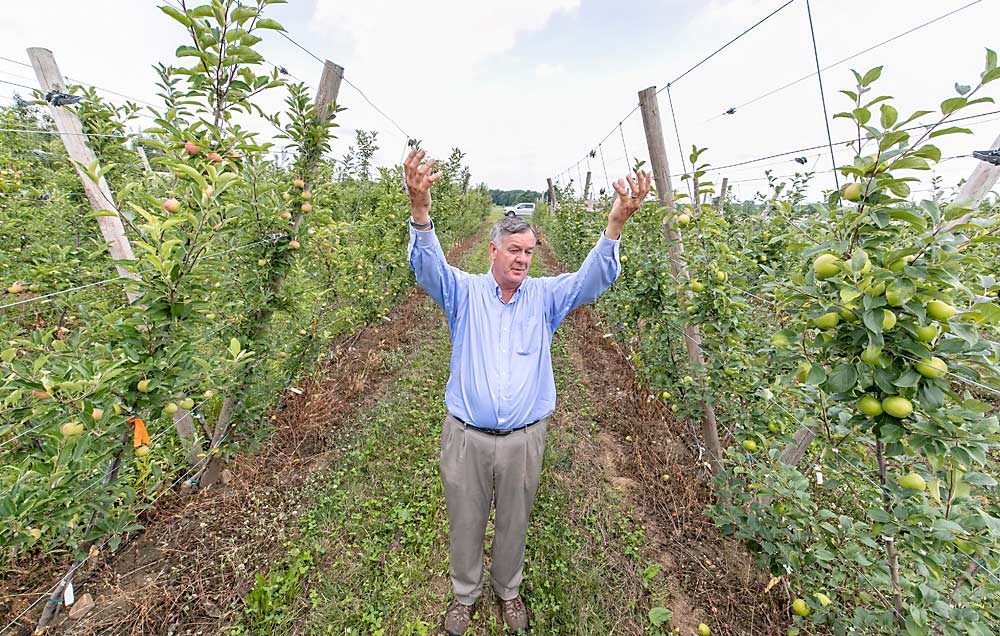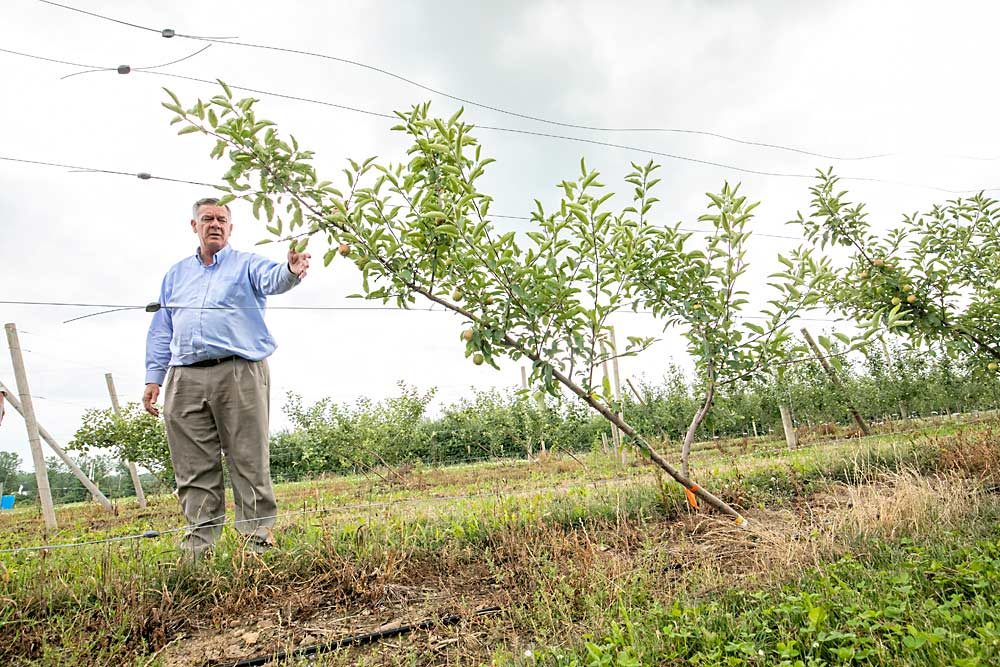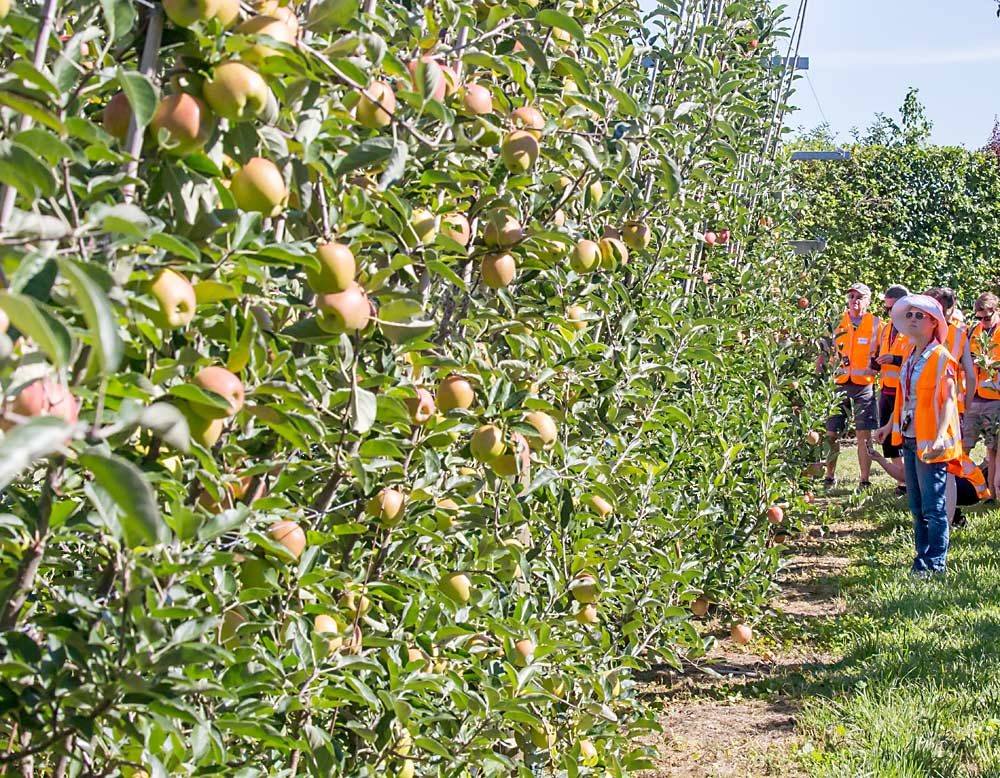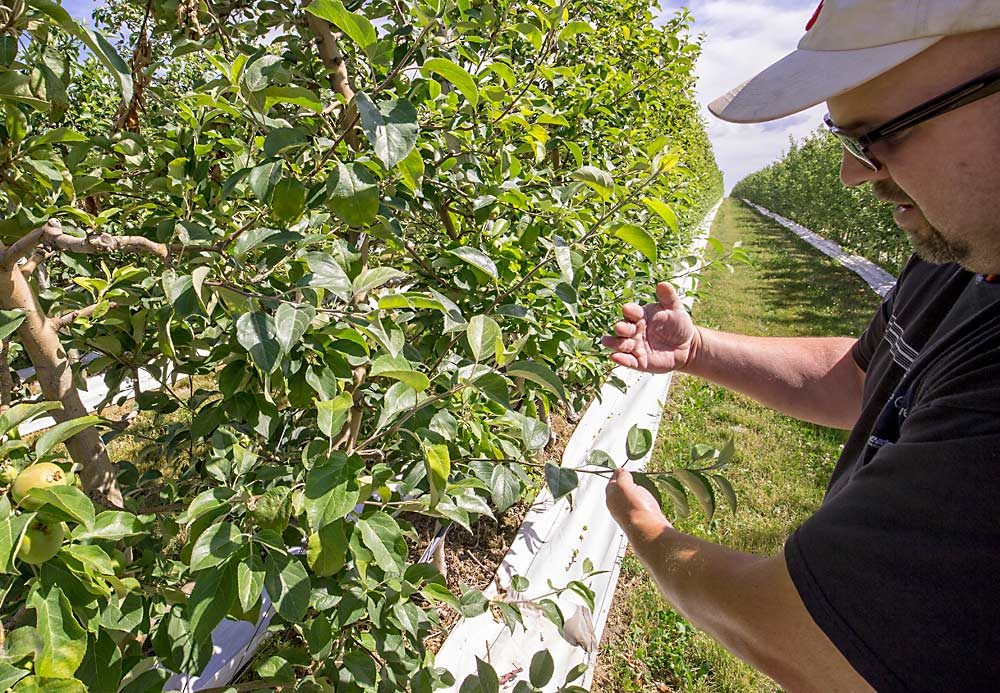
When proven picking robots arrive, Terence Robinson wants growers to be ready. Not just ready to take advantage of labor-saving technology, but ready to understand the trade-off and costs inherent in growing for a robotic future.
That’s why the Cornell University physiologist, who pioneered the tall spindle system in the 1990s, designed his latest systems trial to look at the economics of five “robot-ready” systems — from planting to years into full production.
“All of these systems could be harvested mechanically. The tall spindle may be a little harder than the more 2D canopies, but if a system doesn’t perform with yields comparable with tall spindle, I don’t know if it’s worth it,” Robinson said. “All of my work over the years indicates to me that when we go to extremely narrow rows with more typical row spacing, there’s a penalty you are going to incur with light interception.”
The question: Does the cost savings of mechanized harvest and improved fruit quality from more uniformity pay off, even with some lost productivity? Robinson wants to give growers more information to help answer that question as they plant for the future.
“The robotic harvest focus has been on cost control, but I want to flip the equation and focus on crop value,” he said. “The yield penalty of the 2D systems might be offset by better fruit quality and labor savings, but maybe not.”
Two growers who’ve established their own 2D trials — Rod Farrow of New York and Jeff Cleveringa of Washington — agreed that there’s a productivity cost to growing narrower but said striking the right balance of canopy width will be worth it.
“I’m really encouraged by what Terence is doing,” Farrow said. “I think for a lot of New York growers, his standard tall spindle system is a pretty good option. But that’s not going to lend itself to robotics. That’s a big risk to think you are going to cut yourself off from technology.”
Guided by the light
Walking the trial block at a research orchard in Geneva is disorienting because the row spacing varies with each repeat of the five systems. That’s awkward for management, but crucial to answering the research questions, Robinson said.
He aimed to give each system suitable spacing so that when the canopy fills the allotted space it can achieve 70 percent light interception. That means narrower canopies need narrower row spacing to meet comparable productivity.

The trial compares:
—A tall spindle system planted at 3 feet by 11 feet.
—A narrower tall spindle system planted at 3 feet by 10 feet, which will be hedged in the summer to maintain a narrower canopy starting in the fourth leaf.
—A two-leader system planted at 3 feet by 10 feet.
—A Washington V system, planted at 18 inches by 12 feet, angled at 15 degrees and with branches trained to the wire.
—A multileader system inspired by horticulturist Stuart Tustin’s New Zealand plantings at 6 feet by 8 feet between rows, with eight leaders.
The 2017 planting includes replicates of Gala and Honeycrisp — to compare the economics for a standard and premium variety — both on Geneva 41 rootstocks, except for the multileader planting, which is on the more vigorous G.890.
“G.41 is one of the most productive rootstocks in terms of yield, its efficiency of converting light energy into fruit. But I didn’t think it was powerful enough to fill the trellis” of the multileader system, Robinson said. Even the G.890 hasn’t pushed the trees as well as he’d hoped by the third leaf.
That’s a lesson learned about translocating a system from one region to another. He used the dimensions recommended by Tustin in New Zealand, but in hindsight, the New York climate would have been better suited by 4-foot spacing, rather than 6, and fewer upright shoots, so that the trees could grow into the space faster, Robinson said. In the current system, it lags far behind the competitors and will likely take five years to fill the space, compared to half that for the V-trellis.

“In a way, I’m not giving his system a fair test. In New Zealand, they can grow trees a lot faster than we can,” Robinson said, adding that he plans to work with growers to plant a few more trials of the system, but modified for New York. “One of the things that concerns me is how long it takes to create this canopy.”
In contrast, the V-trellis filled its space well, produced 20 apples per tree in the third leaf, and leads in light interception, Robinson said. Tracking light interception every year as the plantings grow into maturity allows him to show how long the trees take to get there.
“You have light interception X at year 10. But light interception is integral every year,” he said. “When I draw that curve with (Bud.9 rootstocks), it gets there slowly, even though in year 10, it looks great.”
Balancing in the act
In Washington, a handful of growers collaborating with robotic harvest developer Abundant Robotics have been improving their own robot-ready systems for several years. Cleveringa, head of research and development for Starr Ranch Growers, invited the prototype to pick in a Juici block on M.9 rootstock that’s planted at 2 feet by 10 feet and pruned much narrower than the rest of the planting.
“My whole canopy is a foot thick, 6 inches on either side of the wire,” he said. That works very well for the robot. “Last year, my block had 85 percent of the fruit accessible to it.”
Cleveringa estimates that the extremely narrow canopy costs him about 7 to 8 percent of his production and noted that the more narrow fruiting wall results in larger fruit — up half a box size.
“I think the numbers can work with that, especially with our minimum wage going up and up every year,” he said.
Over the three years of trials with Abundant, Cleveringa said he went from 78 percent accessible fruit to 85 percent, due to improvements in both the orchard management and the machine’s vision system. “We just need them in the field picking fruit and we will adapt and learn from them,” he said. “The best system is one where you can have an unobstructed view of the fruit.”
But he doesn’t plan to go any narrower, for fear of losing productivity. “I’m about where I’m comfortable,” Cleveringa said.

In New York, Farrow has been working with computer-vision for crop load assessment, but not yet robotic harvesting. For now, he’s a fan of a 2-foot wide canopy for maximizing fruit quality, despite a small reduction in overall yield.
“I would assume that there is a productivity risk, but the quality value would overcome that,” he said. He’s excited about innovative experiments that go even narrower, too. “But there’s a bit of a limit,” he said. “If we take our canopy from 2 feet to 1 foot, we’d have to have our fruit density up 100 percent, unless we move the rows closer.”
If growers push the limits of what the light interception of the canopy can support — by managing too narrow or cropping too high, or both — the result is lower-quality fruit. Sure, commodity crops are about volume, but repeat sales for premium apple varieties are driven by quality, Farrow said. So, he thinks the conversation about the best system for robot-ready orchards needs to look at maximizing quality and profit.
“If we push that limit and lose some size and color and packout, and grew 15 percent more that all go to juice, it’s not really worth it,” Farrow said.
Robinson focused on profitability, too. The data’s not yet in, but he expects the more extreme 2D systems in the trial to lag about 15 to 20 percent in production, compared to a tall spindle system.
“That’s a lot of boxes of Honeycrisp,” he said. “Yield drives everything in terms of profitability in these systems.” •
—by Kate Prengaman






Leave A Comment